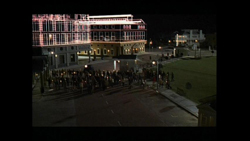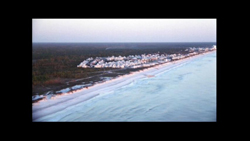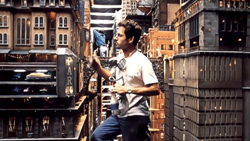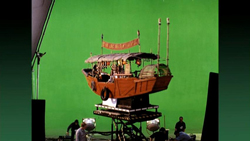technological advances increase possibilities of expression
While Playtime has subtle features that gesture to the relatable city of Paris, The Truman Show, the 1998 film by Peter Weir deploys the opposite technique quite successfully. In Weir’s film, he plays with extremely subtle effects to make an otherwise perfectly real, believable city, seem somehow strange and unnatural. While Tati built the city of his vision, Weir found his idyllic city in Seaside, Florida, and tweaked it to become the controlled, artificial world of the Truman Show. This film begins to combine real and virtual sets as well. The real town of Seaside was combined with renderings to create taller buildings and a denser downtown while maintaining the aesthetic of the actual town. The eeriness of the set comes more from the combination of the city and artificial skies and horizons created by the show’s producers, as well, the audience's knowledge of the entire city being fake, and seeing the dome from the exterior, produces an extremely uncanny sensation.
The use of existing city fabric and architecture is common in films, and often these recognisable elements enhance the uncanniness of the film. Ridley Scott’s 1982 film, Blade Runner, set in a dystopic Los Angeles of 2019, features many pieces of recognisable L.A. architecture. The consistent presence of these iconic buildings, grounds the viewer in the authenticity of the location being L.A. Without these references, the film would appear to be set in some ambiguous oppressive city, however, when it is apparent that this future rendering is of a city familiar to most viewers, it places the condition of the film deeper in the valley of the uncanny, as it becomes something recognisable, and yet not what we know. This sense will certainly vary among viewers, some of whom will be more or less familiar with existing L.A. architecture. For those familiar with it however, the sense of uncanny is altered by the appearance and future program of existing buildings. For example, in a city built around commuters and transportation, the commuter station shuts down and is taken over by a police station. Deckard’s apartment also makes use of some iconic Frank Lloyd Wright architecture, using film angles and lighting to make it appear maze-like and disturbing. Virtual sets are used in this film to create the enormous scale of the city.
While Scott combines recognisably authentic buildings with his physical and virtual sets, Luc Besson uses characteristics of a recognisable city in the sets for his 1997 film, The Fifth Element. His film, set in future New York City, makes use of a combination of scale models, matte painting, live action, and green screening. Unlike Scott’s film, Besson does not include recognisable current New York architecture, instead, he takes iconic characteristics, and carries them through his vertical extrusion of the city, for example the brownstone brick buildings and exit stairs. Thus, Besson creates a city that one can believe as a version of the current one. The vibrant, fantastical nature of the film detracts from the sense of uncanny in this example, while in Blade Runner, the doom and gloom of L.A. 2019 strongly conveyed a debilitating atmosphere. The city of flying cars and the tiny, retractable apartments reaches the point of unreality that the setting begins to rise back out of the uncanny valley and is more comfortable for the viewer because it is more unlike reality. The combination of actual and virtual sets was successful in this film to create what would be otherwise unbelievable scenes and cityscapes.






